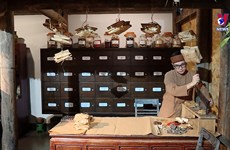Foreign experts discuss intangible cultural heritage preservation
Vietnam is one of the first pioneers to implement the 2003
Convention for Safeguarding Intangible Cultural Heritage..
Vietnam is one of the first pioneers to implement the 2003
Convention for Safeguarding Intangible Cultural Heritage, which has been
adopted by 100 nations round the world in effort to protect their
cultural heritage.
UNESCO Director General Irina Bokova was speaking at a recent international seminar on experiences and orientations for preserving intangible cultural heritage in Vietnam’s central Quang Nam province.
The Vietnamese government’s determination and action were a source of encouragement to its people to get them involved in preserving and upholding intangible cultural heritage, and sharing valuable historical assets and cultural diversity, she said.
Vietnamese localities should make greater preservation efforts for the long term, she said, adding that culture gives birth to heritage and plays a key role in the development process.
Professor Dr. Dawnhee Yim from Donggok University in the Republic of Korea (RoK) shared some experiences in safeguarding intangible cultural heritage.
Over the past four decades, masterpieces of the oral and intangible heritage of humanity have become a focal point in conservation policies of the Convention on Protecting Intangible Cultural Heritage in the RoK.
However, rapid modernisation and urbanisation has created changes in time-honoured traditions, which may pose a threat to intangible cultural heritage such as traditional customs and rituals, the professor said.
Professor Dr. Roger L. Janelli from Bloomington University in the US highlighted the importance of the concepts of tangible and intangible in cultural heritage. He cited the Pyramids in Egypt and the Ho Dynasty Citadel in Vietnam as typical examples of tangible heritage.
These heritage sites are of great significance to local people and have become symbols of their nations. Similarly, festivals and religious rituals are vivid examples of intangible heritage featuring traditional costumes, musical instruments and other items.
Dr. Tvrtko Zebec from the Croatia Institute of Ethnology and Folklore Research suggested making digitalised documents of cultural heritage.
Writings, photographs, videos and audio files are a vital source of input for advertising culture and establishing a network of heritage owners. This will help researchers and scientists in their work and offer the public easier access to heritage documents. It will also make it easier and more convenient for heritage owners, cultural organisations, policy makers and tour operators to fully tap the potential of cultural heritage, he added.-VNA
UNESCO Director General Irina Bokova was speaking at a recent international seminar on experiences and orientations for preserving intangible cultural heritage in Vietnam’s central Quang Nam province.
The Vietnamese government’s determination and action were a source of encouragement to its people to get them involved in preserving and upholding intangible cultural heritage, and sharing valuable historical assets and cultural diversity, she said.
Vietnamese localities should make greater preservation efforts for the long term, she said, adding that culture gives birth to heritage and plays a key role in the development process.
Professor Dr. Dawnhee Yim from Donggok University in the Republic of Korea (RoK) shared some experiences in safeguarding intangible cultural heritage.
Over the past four decades, masterpieces of the oral and intangible heritage of humanity have become a focal point in conservation policies of the Convention on Protecting Intangible Cultural Heritage in the RoK.
However, rapid modernisation and urbanisation has created changes in time-honoured traditions, which may pose a threat to intangible cultural heritage such as traditional customs and rituals, the professor said.
Professor Dr. Roger L. Janelli from Bloomington University in the US highlighted the importance of the concepts of tangible and intangible in cultural heritage. He cited the Pyramids in Egypt and the Ho Dynasty Citadel in Vietnam as typical examples of tangible heritage.
These heritage sites are of great significance to local people and have become symbols of their nations. Similarly, festivals and religious rituals are vivid examples of intangible heritage featuring traditional costumes, musical instruments and other items.
Dr. Tvrtko Zebec from the Croatia Institute of Ethnology and Folklore Research suggested making digitalised documents of cultural heritage.
Writings, photographs, videos and audio files are a vital source of input for advertising culture and establishing a network of heritage owners. This will help researchers and scientists in their work and offer the public easier access to heritage documents. It will also make it easier and more convenient for heritage owners, cultural organisations, policy makers and tour operators to fully tap the potential of cultural heritage, he added.-VNA












